Diamond CertificatesWhen buying a diamond over 0.3ct, the diamond needs to have a GIA certificate, while there are many profit making diamond certification companies with sometimes lofty names these do not use the same grading system as the not for profit GIA trade body, usually they will inflate the quality described while still using the same terms as the GIA.
If you want to get what you paid for make sure you get the GIA cert.
Diamonds under a carat certified by the GIA will have the certificate number laser inscribed on the side of the diamond, while the printing is very small it pays to check it with the the GIA website on
www.gia.edu/report-check-landing. For diamonds over a carat the certificate will have a drawing as to were the inclusions are in the diamond, try to locate a few with a magnifying glass. Do this when collecting the jewellery or as soon as is practical if it is send to you. We will always be happy to show you these when collecting from us.
 Diamond colour
Diamond colourDiamonds are graded using a GIA colour scale that ranges from ‘D‘ (completely colourless) to ‘Z‘ (tinted yellow). We do not use diamonds with tints below ‘M‘ as they tend to look dull . The higher the colour the brighter the diamond and this is the part of your choice were your money is best spent. The first three colours ‘D‘ ‘E‘ ‘F‘ are colourless and are recommended for the purist. Colours ‘G‘ ‘H‘ are near colourless . They are easily the colours we recommend for most clients although sometimes the price difference between ‘F‘ and ‘G‘ can be small. Colours ‘J‘ ‘K‘ ‘L‘ ‘M‘ show faint colour and are recommended for the budget conscious.
It is really pretty simple. The closer to ‘D‘ you go, the more expensive the diamond. Can you see the difference between a ‘D‘ colour and a ‘K‘ colour? In fact the ‘K‘ colour will look pretty dull in comparison to a D. However, if you look at 2 diamond rings from a distance, it becomes a lot more difficult to tell the difference between them. Most people will not be able to tell the difference between a ‘ D‘ and a ‘G‘ colour when mounted. If you‘re the type of person who wants the absolute best, by all means purchase a ‘D‘ colour; but don‘t be surprised if a lower colour grade looks just as good.
 Diamond clarity
Diamond clarityMost diamonds have imperfections also called inclusions. The clarity grade is based on how many and how pronounced these inclusions are. The drawings below give you an illustration of the qualities.
Put simply, the fewer blemishes the more expensive the diamond. Can you see the difference between an ‘IF‘ (flawless) clarity and a ‘VS2‘ clarity? without the help of a magnifying glass NO! (and even with a magnifying glass most of our customers struggle to see any of the inclusions in a VS1 clarity diamond). You can buy a flawless or a VVS graded diamond but the visual appearance of the diamond remains the same. You can start to notice a difference in the brilliance of a diamond when you look at an SI clarity diamond with the I1 to I3 clarity diamonds showing a noticeable reduction in beauty. Most people will not be able to tell the difference between a ‘IF‘ and ‘VS2‘ clarity diamond when mounted. Although there is an undeniable attraction in owning a flawless diamond a VS2 clarity diamond looks just as good.
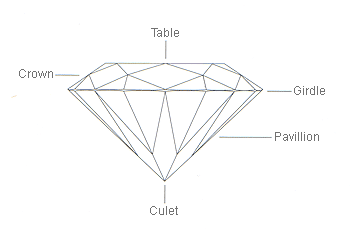 DiamondCut
DiamondCutAt Cool Diamonds we only use the independent internationally recognised non profit trade body, the GIA (http://www.gia.edu).
On an GIA certificate, the diamond is given three grades for the level of cut. these are cut,symmetry and polish. The grading scale in is as follows: Excellent - Very Good - Good - Fair - Poor.
First a grade for ‘Cut‘. This refers directly to the cut of the diamond. This refers to the relationship between the various parts of the stone, i.e., the width in relation to the depth of the diamond and the percentage of surface the table (the flat facet on the top part of the stone) has in relation to the width of the diamond. If these relationships are not optimal, the fire and brilliance of the diamond are affected, and undesirable visual effects may occur. It is therefore the nature and extent of these effects that combine to give the diamond the final grade.
Second, the diamond is also awarded a grade for Symmetry with the relationship between the various part of the diamond described separately. While this is more difficult to explain without showing you a diamond, if the symmetry is not optimal the diamond will loose some of it‘s brillance and fire.
Third, the diamond is graded for ‘Finish‘ this relate to how smooth the surface of the diamond is and as a rule the smoother the more transparent and attractive the diamond.
The minimum grade that Cool Diamonds stock on either certificate is ‘Good‘ and this relates to the ‘Good‘ option under ‘Proportions/Symmetry/cut‘ on our website. Diamonds with grades above ‘Good‘ are priced as ‘Premium‘.
We would normally recommend a ‘Premium‘ cut over a ‘Good‘ cut as the difference is more noticeable to the human eye than for example the difference between a VS1 and a VS2 clarity.
You will sometimes read about ‘Ideal cut‘, be aware that it is a marketing terms and the GIA does not recognise this cut grade.
Carat weight
The weight of a diamond is measured in carats. One carat (Crt.) Equals 1/5th of a gram. A carat is divided in 100 points so that a diamond of 50 points equals 1/2 a carat. The larger diamonds are much rarer and their value increases exponentially with size. A diamond of 1/2 a carat has a approximate diameter of 5.2mm , one of 1 carat 6.3mm and one of 2 carats 8mm.
Although the weight of a 0.50 carat is half that of a carat diamond the size difference is only 25%, this is because most of the weight of a diamond is at the bottom part of the stone.
Diamond Fluorescence
One of the less understood characteristic of a diamond is it‘s level of fluorescence yet it greatly affects the brilliance and sparkle of the diamond. We only sell diamonds with none or faint fluorescence as these will sparkle the most.
Diamonds with medium, strong or very strong can be significantly cheaper but they simply do not look as nice.
Diamond Shapes
Diamonds are cut in a variety of shapes.
The shape that sparkles the most is the modern round brilliant cut designed by a mathematician diamond cutter called Tolkofsky.
The second most sparkly would be the square shaped princess cut diamond.
The least sparkly shape is the rectangular cut ‘Emerald cut‘ diamond.
The Gia will only award a cut grade for round diamonds as the sparkle in other shapes can not be accurately measured and is subjective to the taste of the viewer.
Carat weight
The weight of a diamond is measured in carats. One carat (Crt.) Equals 1/5th of a gram. A carat is divided in 100 points so that a diamond of 50 points equals 1/2 a carat. The larger diamonds are much rarer and their value increases exponentially with size. A diamond of 1/2 a carat has a approximate diameter of 5.2mm , one of 1 carat 6.3mm and one of 2 carats 8mm.
Although the weight of a 0.50 carat is half that of a carat diamond the size difference is only 25%, this is because most of the weight of a diamond is at the bottom part of the stone.
Flawless diamond
A flawless diamond is a diamond with no inclusions visible to a diamond grader using 10 times magnification.

VVS1 diamond
VVS1 inclusions are very difficult to see using 10 times magnification therefore, we use a picture taken at 63 times magnification. Even a diamond grader will struggle to find a vvs1 inclusion with a magnifying glass.
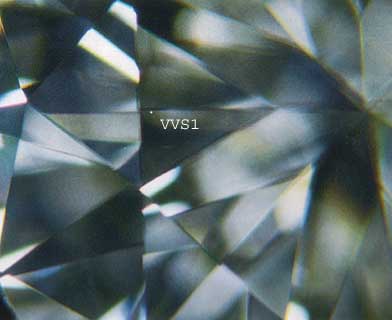
VVS2 diamond
VVS2 inclusions are once again very difficult to see at 10 times magnification, as in the VVS1 you need to have a specialist training in gemology in order to see the inclusions even using a magnifying glass.
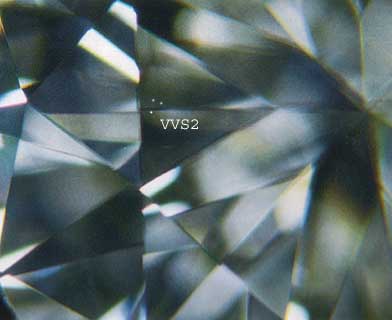
VS1 diamond
In a VS1 the inclusions are difficult for a non professional diamond grader to see. Using a magnifying glass some members of the public will be able to see the inclusions but most will not.
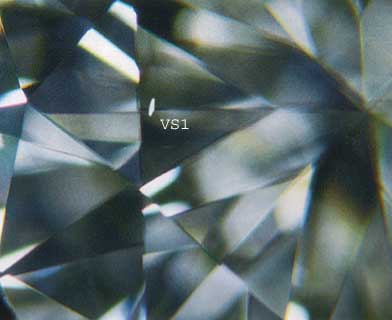
VS2 diamond
In a VS2 it is relatively easy to see the inclusions using a magnifying glass but these cannot be seen with the naked eye.
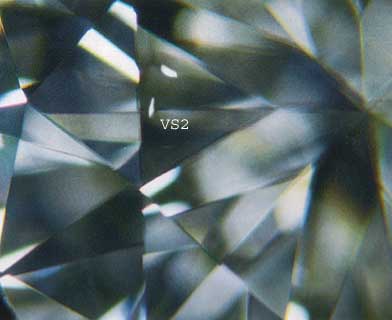
SI1 diamond
In an Si 1 grade inclusions are usually very easy to locate when examined with a magnifying glass but these should not normally not be visible to the naked eye when viewing the diamond from the top, you can sometimes see it from the side though.

SI2 diamond
The SI2 grade bridges the gap between the slightly included diamond and highly included diamond. These are diamonds that contain inclusions easily seen with a magnifying glass, and may be visible to the naked eye depending on how good your eyesight is.
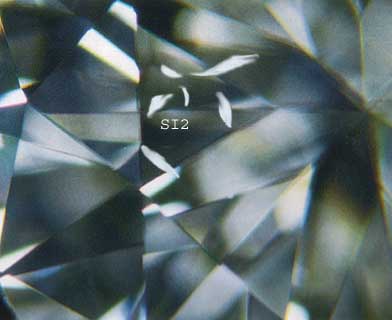
SI3 diamond
Si3 is not a GIA recognized grade.

I1 diamond
These diamonds usually contain large, unsightly inclusions. Some inclusions are visible without magnification.
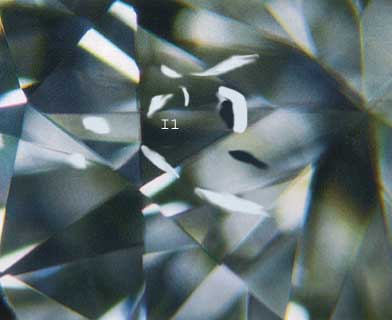
I2 diamond
I2 categorises diamonds with potentiality dangerous inclusions that can affect beauty and durability. They are obvious to the unaided eye.

I3 diamond
The fact that an I3 diamond has stayed together is quite a remarkable feat as in these diamonds durability is jeopardised and beauty is compromised. Every diamond has a quality and these happen to be the lowest.
Clarity information on this page is based on the excellent book ‘Photo Masters for Diamond Grading‘ by Gary A. Roskin, G.G.,F.G.A.

Conflict Diamonds
Conflict diamonds are diamonds that originate from areas controlled by forces or factions opposed to legitimate and internationally recognized governments. They are used to fund military action in opposition to those governments, or in contravention of the decisions of the United Nations Security Council. Conflict diamonds are the crack cocaine of the jewellery trade. It is something that is abhorrent and evil to any sane person. In May 2000, an initiative was launched in Kimberley, South Africa that aims to break the link between the legitimate trade in diamonds and conflict diamonds. It is called the Kimberley process. We recommend that consumers ask their jeweller whether they adhere to the Kimberley process and the official certification methods associated with it. Conflict diamonds compromise international peace and human security and hamper economic and social development in affected countries. The best way to promote a world free of conflict diamonds is to ensure that every retailer is 100% fully compliant with the Kimberley process.
All Cool Diamonds diamonds have been purchased from legitimate sources not involved in funding conflict and in compliance with United Nations resolution. We hereby guarantee that our diamonds are conflict free, based on personal knowledge and/or written guarantees provided by the supplier of our diamonds.


 Diamond colour
Diamond colour Diamond clarity
Diamond clarity DiamondCut
DiamondCut









